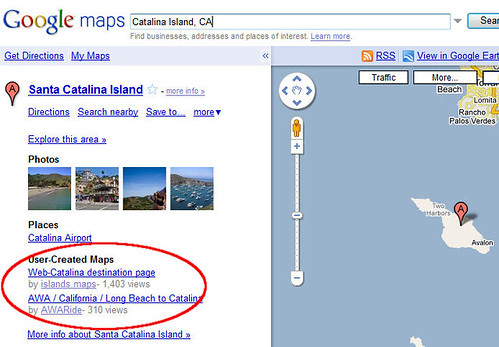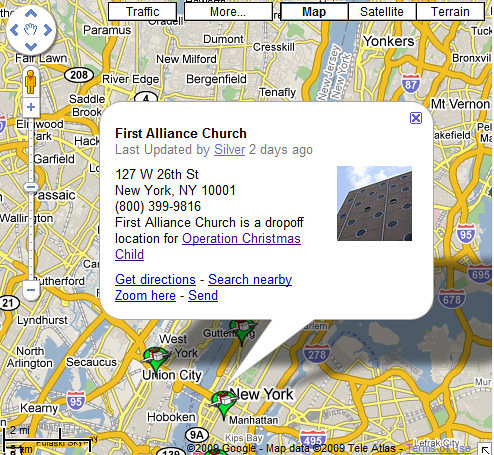Google Custom Maps: A Goldmine For Local Businesses
This past week at SMX East, I presented a longer-tail marketing tactic for Google Maps — creation and uploading of place marks data into the customizable "My Maps" section. For companies and individuals who have some rich local data to share, or local place expertise, My Maps may be for you!
This past week at SMX East, I presented a longer-tail marketing tactic for Google Maps—creation and uploading of place marks data into the customizable “My Maps” section. For companies and individuals who have some rich local data to share, or local place expertise, My Maps may be for you!
If you’ve ever wished that you could engineer the Google Maps interface to highlight and display your local content, My Maps could be something of a dream-come-true. For content publishers, imagine if your content was pinpointed and presented throughout Google Maps, making it easy for people who are exploring local areas virtually to discover you? For small mom-and-pop businesses, imagine if consumers were able to find you via hundreds or thousands of listings in Google Maps instead of just one?
People frequently search for local places via maps—indeed, Hitwise counts four map sites in the top ten of its travel category. While inside the maps, there are a few ways by which searchers may be exposed to user-generated maps. First, in the left sidebar of Google Maps are displayed image thumbnail icons related to the query and below that are links to some of the top user-submitted maps:
Second, within the new Place Pages generated for each location, and on individual Place Pages for businesses, there are also links to various user-submitted links.
On these pages, the user-submitted maps which rank highest are typically those which are more popular and have the most views. Subject matter of things plotted in maps may be constrained by your content, but keywords in map names, map descriptions and appropriateness of map names to the area pinpointed by the maps Placemarks also affect how often searchers will see and click to view the custom maps.
Some of the custom maps have received significant numbers of click-throughs! I’ve seen some with over 60,000 views—an indication that these can sometimes be very worthwhile sources for referral traffic, if engineered well.
There are all sorts of useful custom maps that one could provide about local areas. Companies which develop value-add information maps about local areas could easily reap the benefit of having more content within Google Maps which can convert to more traffic to their websites. Some examples I’ve seen include a blog about coffee which pinpointed independent coffee shops of Denver, a map of local tourist destinations at Catalina Island, and maps for Silicon Valley cafes provided by Mapplr.
Those who create custom maps are provided with an unprecedented degree of control over content presented. As an example, I created a custom map for a non-profit group’s local area connection points, Operation Christmas Child’s New York drop-off locations. As you can see, I was able to customize the display of the information bubbles for each location by adding a description that included name, street address, phone number and a small pic from their website:
Within each, I also added a link back to Operation Christmas Child’s website.
This resulted in increased exposure for the charitable organization. Those dropoff locations now appear in Google Maps search results when one searches for “operation christmas child, new york,” and the link to the custom map now appears in those dropoff organizations’ Google Place pages.
The promotional value of such custom maps is clear for organizations and many businesses. By uploading useful locational info into Google Maps, you can increase your exposure and it can open up another long-tail channel for referral traffic.
Google’s My Maps can be generated in a few ways. One may click to create a map by hand. One may develop a KML file that pinpoints placemarks to be manually uploaded into Google’s My Maps. And, one can create a KML file and submit it for crawling via Sitemaps protocol (Here’s a link to the example KML file I created for the Operation Christmas Child NYC Map).
Tips for creating Google “My Maps:”
- Build out your Google Profile page. You can leverage brand name value with a well-chosen profile name. The Profile page ought to have a good custom avatar icon and should include links back to your website pages.
- Create maps that are useful.
- Link to the custom maps you build from your website.
- Customize the information bubble content for your placemarks.
- Include links in the info bubble content back to related pages on your site that provide additional information.
- Design custom placemark icons.
- If you’re providing more info about businesses already within Google Maps’ directory, use the same name for your placemarks as the business name to facilitate the My Map links to appear in the business’s Place page.
- Remember to include vitally-useful details such as addresses and phone numbers for placemarks where it makes sense to do so—leaving out those details harms usability.
Creating elegant and effective custom maps within Google Maps is easy to do and is one long-tail tactic that relatively few companies have exploited. If you use My Maps to promote a business or a site as I’ve described, be sure to leave comments below this article linking-to and describing the maps you’ve created!
Contributing authors are invited to create content for Search Engine Land and are chosen for their expertise and contribution to the search community. Our contributors work under the oversight of the editorial staff and contributions are checked for quality and relevance to our readers. The opinions they express are their own.
Related stories

